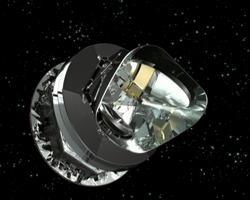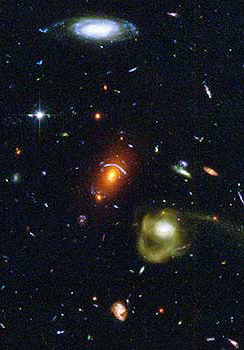Planck satellite explores the infancy of the universe
Using new data from the Planck satellite, researchers can now show that the universe is not expanding as fast as previously thought and the universe is 80 million years older than we thought. Researchers from the Niels Bohr Institute are among those taking part in the research project that is providing revolutionary new knowledge about the universe.
Space, as we know it, with billions of stars, planets and giant galaxies has from time immemorial been fundamentally different. A primordial soup of hot plasma and dense energy, which had not formed atoms, had not yet formed gases like hydrogen and helium, which could be the start of star formation. Without stars to emit light the universe was dark and how do you observe a dark universe? How do you explore the infancy of the universe?

The Planck satellite changes direction every hour and rotates once a minute on its own axis. These movements mean that it scans the entire universe every six months. This means that instead of getting a limited telescope view in one direction, you get a complete and very detailed map of the universe in all directions. Planck has a very sophisticated detector system that measures the cosmic microwave radiation at nine different frequencies ranging from 23 Ghz to 857 Ghz.
In order to understand the fundamental properties of the early universe, the European Space Agency, ESA, launched the Planck Satellite into space on 14 May 2009, where it reached its position and moved into Earth’s orbit after just 50 days. Its mission is to observe all the way back to the infancy of the universe and measure the cosmic microwave radiation with unprecedented accuracy. Microwave radiation appeared along with the birth of the universe, the Big Bang, and by mapping the cosmic microwave radiation, we can reveal new details about the early universe 380,000 years after the Big Bang.
First results released
After a journey of 1.5 million kilometers out in space, the satellite reached its position in space in July 2009. It then took about half a year to adjust it. Then data began to flow down to Earth. Research groups from 8 countries are participating in the mission, including researchers from the Niels Bohr Institute. On Thursday, 21 March the first results were released at a press conference at ESA headquarters in Paris.
Researchers are each working within their area of expertise and smaller teams within the Planck Collaboration contribute components to the overall project. The researchers follow the presentation of the results intensely – both at the conference in Paris and at home via the online connection to the conference.
“It is very exciting data that gives us a new understanding of the earliest universe,” explains Martin Kirstejn Hansen, a PhD student at the Niels Bohr Institute at the University of Copenhagen. He is affiliated with the Planck project and is following the new research results closely.
Universe older that previously believed

Using new data from the Planck satellite, researchers can now show that the universe is not expanding as quickly as previously thought and the universe is 80 million years older than previously believed. The results also show that the visible matter like stars, planets, moons, gas clouds and galaxies make up 4.9% of the universe, which is more than previously thought.
The previous assessment from the earlier satellite, WMAP, was that the universe is only comprised of 4.5 percent visible matter like stars, planets, moons, galaxies and dust clouds. 22.7 percent is made up of the so-called dark matter, which no one knows what it is, but they can calculate that it is out there using gravitational measurements. And 72.8 percent of the universe is dark energy, which is believed to be responsible for the universe expanding at a faster and faster rate, that is, that it is accelerating its expansion.
The new and much more accurate results from Planck show that there is a greater amount of visible matter, that is to say, 4.9 percent. The amount of dark matter is also greater, at 26.8 percent, while the amount of dark energy is lower, at 68.3 percent.
Martin Kirstejn Hansen explains that the Hubble constant is also different from what almost all other experiments have measured. The Hubble constant indicates how quickly the galaxies are moving away from each other. It has been shown to be 67.15 km/sec. per megaparsec, where it was previously said to be around 72 km/sec. per megaparsec. The expansion of the universe is thus slower than previously thought. The Hubble constant is used to determine distances in the universe and a change in this value will have major implications for astronomy, since many of the distances astronomers calculate will now have to be changed.
Intriguingly, the universe appears to be older than previously thought. It has gone from 13.7 billion yeas old to 13.8 billion years – to be precise, it is 80 million years older than previously thought.
More about the Planck satellit and the mission >>
News about the Planck results >>
